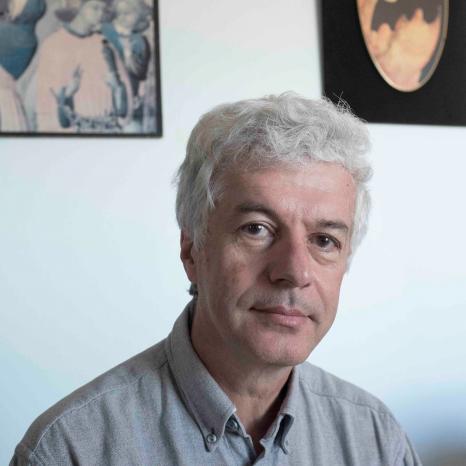
Guy David: Solving the soap bubble equation
Guy David is a teacher and researcher at the Orsay mathematics laboratory (LMO - Université Paris-Saclay, CNRS). He is studying the geometric theory of measure, calculus of variations and partial differential equations. He teaches in the Mathematics Department of the University. His recent research concerns, for example, the theoretical description of soap films. Today, he is mainly interested in a concept of harmonic measure adapted to domains with small edges. The French Academy of Sciences has just awarded him the 2020 Ampère prize.
“Partial differential equations represent the way we model nature,” Guy David says. “It is common practice, for example, to describe the weather with variables such as air pressure or temperature. If we know the air pressure on Earth at a given time, then we should be able to tell the pressures for all other times.” From there, mathematicians ask themselves three questions: Do their equations describe the nature around them? Will they be able to solve them? And once these two steps have been taken, will they also be able to resolve them practically?
Harmonic measure
The study of the relationships between the geometry of a domain (the inside of the lung) and harmonic measure (the distribution of air at the interface) is one of the great classics of partial differential equations. A small particle of air enters it and the question is how far it reaches inside the lung. “The lung is made to have the largest possible surface area, to allow maximum exchange between oxygen and carbon dioxide, and therefore has a multitude of cavities,” Guy David explains. “The question is whether the air, whose movement is described by a Brownian motion, can reach all parts of the lung or only a small part. In this case, the so-called harmonic measure describes the part of the lung that can be reached by air. The way air moves (Brownian motion) is then governed by a simple partial differential equation, Laplace’s equation, which is a good model of what are called elliptic equations,” he says.
Significant progress has recently been made. With two other researchers, Guy David has introduced a different class of elliptic operators, adapted to domains with a much smaller boundary. The Brownian motion analogue is thus pushed towards the edge (otherwise it could pass by without seeing it!). The study of harmonic measure proved to be fascinating here, and also allowed a better understanding of certain problems that remained unaddressed in the classical case of Laplace's equation.
Calculus of variations and soap films
One of the useful tools for the study of harmonic measure is the so-called geometric measure theory, a way to study in detail the regularity of sets in Euclidean space. What do they most often look like? On plans? With what error estimates? What can we deduce about all kinds of objects associated with these sets? It is also one of the main tools of the “calculus of variations”. Many phenomena are governed by the minimisation of “functionals”, and the main goals of the calculus of variations are to demonstrate the existence of functions, or configurations, that minimise these functionals. And then to study these minimal configurations in detail. A very good example, studied by Guy David, is the description of soap films and bubbles. In this case, the model consists in saying that these films and bubbles minimise a very simple quantity, the total area, with the constraint of leaning on a given edge, which corresponds to dipping a wire in soap and looking at the surface formed (or containing given volumes in the bubbles). “It's called Plateau’s problem, which is precisely about having surfaces that rest on a given edge (the wire) and a minimum area,” researcher Mr David explains. “In fact, there are many ways to give precise meanings to the terms “leaning” and “surface area”, which have resulted in some wonderful pages of mathematics. But curiously, the one I prefer and which seems to me to best describe practical soap films, the theorem of the existence of minimisers is not yet known, even for surfaces of dimension 2 in Euclidean space of dimension 3, with an edge that is a smooth curve,” he said.
Find the missing theorem
Guy David is a pure mathematician. “I like the fact that the minimal surfaces I'm studying do indeed resemble the soap films of everyday life. I see in this case a surprising and pleasing adequacy of a very simple modelling with reality. But if the actual soap films didn't check the properties I demonstrate, I wouldn't be far from judging that they are just wrong or more seriously that the model was worse than expected,” he says.
A very nice theorem by Jean Taylor, written in the 70s, gives a complete local description of soap films, far from the border: they are obtained from smooth surfaces which can join together in groups of 3, with angles of 120 degrees and along curves which, themselves, can only join at their ends in groups of 4 and with equal angles. “It's easy to observe on real soap films, but Taylor promises that you'll never be able to build more complicated singularities,” observes Guy David, who hopes one day to demonstrate a similar nomenclature for the possible ways in which film can attach to the edge. “Even for a smooth edge, this nomenclature has not yet been demonstrated!” he says.
A passion for mathematics
As far back as he can remember, Guy David has always loved maths. “The education system being based on it, there were all kinds of options available to me and I never had a difficult choice to make,” he said. So he entered the École normale supérieure (ENS) in 1976, then defended his postgraduate thesis at Université Paris-Sud under the supervision of Yves Meyer. From 1982 to 1989, he was a research associate at the Centre de mathématiques of the École Polytechnique. In 1989, he became a professor at Université Paris-Sud. “I love teaching, but my primary motivation is to do research in mathematics,” Guy David admits. He fondly remembers the invention of his first theorem, at less than 30 years of age, and his other successes, such as the invention with mathematician Stephen Semmes of uniformly rectifiable sets and the partial resolution of Vitushkin's conjecture in 1998. The French Academy of Sciences' Ampere 2020 prize has a prominent place in his personal achievements. “Like a lot of mathematicians, I tend to think that I don't deserve the rewards, but deep down I'm no longer shunning my own pleasure, because it's proof that colleagues appreciate my work.”

